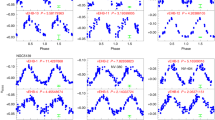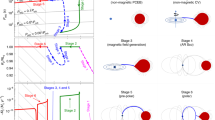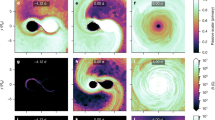Abstract
Planetary nebulae are thought to be formed when a slow wind from the progenitor giant star is overtaken by a subsequent fast wind generated as the star enters its white dwarf stage1. A shock forms near the boundary between the winds, creating the relatively dense shell characteristic of a planetary nebula. A spherically symmetric wind will produce a spherically symmetric shell, yet over half of known planetary nebulae are not spherical; rather, they are elliptical or bipolar in shape2. A magnetic field could launch and collimate a bipolar outflow, but the origin of such a field has hitherto been unclear, and some previous work has even suggested that a field could not be generated3. Here we show that an asymptotic-giant-branch (AGB) star can indeed generate a strong magnetic field, having as its origin a dynamo at the interface between the rapidly rotating core and the more slowly rotating envelope of the star. The fields are strong enough to shape the bipolar outflows that produce the observed bipolar planetary nebulae. Magnetic braking of the stellar core during this process may also explain the puzzlingly4 slow rotation of most white dwarf stars.
This is a preview of subscription content, access via your institution
Access options
Subscribe to this journal
Receive 51 print issues and online access
$199.00 per year
only $3.90 per issue
Buy this article
- Purchase on Springer Link
- Instant access to full article PDF
Prices may be subject to local taxes which are calculated during checkout

Similar content being viewed by others
References
Kwok, S., Purton, C. R. & Fitzgerald, P. M. On the origin of planetary nebulae. Astrophys. J. 219, L125–L127 (1978).
Manchado, A., Villaver, E., Stanghellini, L. & Guerrero, M. in Asymmetrical Planetary Nebulae II. From Origins to Microstructures (eds Kastner, J. H., Stoker, N. & Rappaport, S.) 17–23 (ASP Conf. Ser. 199, Astronomical Society of the Pacific, San Francisco, 2000).
Soker, N. & Harpaz, A. Can a single AGB star form an axially symmetric planetary nebula? J. Astron. Soc. Pac. 104, 923–930 (1992).
Koester, D., Dreizler, S., Weidemann, V. & Allard, N. F. Search for rotation in white dwarfs. Astron. Astrophys. 338, 612–622 (1998).
Balick, B. The evolution of planetary nebulae. I—Structures, ionizations, and morphological sequences. Astron. J. 94, 671–678 (1987).
Soker, N. & Livio, M. Interacting winds and the shaping of planetary nebulae. Astrophys. J. 339, 268–278 (1989).
Mellema, G., Eulderink, F. & Icke, V. Hydrodynamical models of aspherical planetary nebulae. Astron. Astrophys. 252, 718–732 (1991).
Icke, V., Balick, B. & Frank, A. The hydrodynamics of aspherical planetary nebulae. II. Numerical modelling of the early evolution. Astron. Astrophys. 253, 224–243 (1992).
Gurzadyan, G. Planetary Nebulae (Gordon and Breach, New York, 1969).
Pascoli, G. La nature des nébuleuses planétaires bipolaires. Astron. Astrophys. 180, 191–200 (1987).
Matt, S., Balick, B., Winglee, R. & Goodson, A. Disk formation by asymptotic giant branch winds in dipole magnetic fields. Astrophys. J. 545, 965–973 (2000).
Chevalier, R. A. & Luo, D. Magnetic shaping of planetary nebulae and other stellar wind bubbles. Astrophys. J. 421, 225–235 (1994).
García-Segura, G., Langer, N., Rozyczka, M. & Franco, J. Shaping bipolar and elliptical planetary nebulae: effects of stellar rotation, photoionization beating, and magnetic fields. Astrophys. J. 517, 767–781 (1999).
Blackman, E. G., Frank, A. & Welch, C. MHD stellar and disk winds: Application to planetary nebulae. Astrophys. J. (in the press).
Cox, A. N. Allen's Astrophysical Quantities 4th edn, 389 (AIP Press, New York, 1999).
Peterson, R. C. The rotation of horizontal-branch stars. II. Members of the globular clusters M3, M5, and M13. Astrophys. J. 275, 737–751 (1983).
Pinsonneault, M., Deliyannis, C. P. & Demarque, P. Evolutionary models of halo stars with rotation. I. Evidence for differential rotation with depth in stars. Astrophys. J. 367, 239–252 (1991).
Behr, B. B. et al. A new spin on the problem of horizontal-branch gaps: stellar rotation along the blue horizontal branch of globular cluster M13. Astrophys. J. 528, 849–853 (2000).
Livio, M. & Pringle, J. E. The rotation rates of white dwarfs and pulsars. Astrophys. J. 505, 339–343 (1998).
Thomas, J. H., Markiel, J. A. & Van Horn, H. M. Dynamo generation of magnetic fields in white dwarfs. Astrophys. J. 453, 403–410 (1995).
Parker, E. N. A solar dynamo surface wave at the interface between convection and nonuniform rotation. Astrophys. J. 408, 707–719 (1993).
Markiel, J. A. & Thomas, J. H. Solar interface dynamo models with a realistic rotation profile. Astrophys. J. 523, 827–837 (1999).
Blackman, E. G. Overcoming the back reaction on turbulent motions in the presence of magnetic fields. Phys. Rev. Lett. 77, 2694–2697 (1996).
Pick, M. in Ninth European Meeting on Solar Physics: Magnetic Fields and Solar Processes (ed. Wilson, A.) 183 (ESA SP Series SP-448, European Space Agency, 1999).
Trammell, S. R. in Asymmetrical Planetary Nebulae II. From Origins to Microstructures (eds Kastner, J. H., Soker, N. & Rappaport, S.) 147–150 (ASP Conf. Ser. 199, Astronomical Society of the Pacific, San Francisco, 2000).
Sahai, J. in Asymmetrical Planetary Nebulae II. From origins to Microstructures (eds Kastner, J. H., Soker, N. & Rappaport, S.) 209–216 (ASP Conf. Ser. 199, Astronomical Society of the Pacific, San Francisco, 2000).
Alcolea, J. et al. in Asymmetrical Planetary Nebulae II. From Origins to Microstructures (eds Kastner, J. H., Soker, N. & Rappaport, S.) 347–354 (ASP Conf. Ser. 199, Astronomical Society of the Pacific, San Francisco, 2000).
Königl, A. & Pudritz, R. in Protostars and Planets IV (eds Mannings, V., Boss, V. A. & Russel, S.) 759–791 (Univ. Arizona Press, Tucson, 2000).
Tsinganos, K. & Bogovalov, S. Magnetic collimation of solar and stellar winds. Astron. Astrophys. 356, 989–1002 (2000).
Lery, T., Heyvaerts, J., Appl, S. & Norman, C. Outflows from magnetic rotators. Astron. Astrophys. 337, 603–624 (1998).
Balick, B. et al. FLIERs and other microstructures in planetary nebulae. IV. Images of elliptical PNs from the Hubble Space Telescope. Astron. J. 116, 360–371 (1999).
Palen, S. & Fix, J. D. Models of OH maser variations in U Herculis. Astrophys. J. 531, 391–400 (2000).
Acknowledgements
We are grateful to S. Kawaler and to F. D'Antona and P. Ventura for making available to us detailed tables of their evolutionary models for AGB stars. This work was supported by the NSF, NASA and the DOE.
Author information
Authors and Affiliations
Corresponding author
Rights and permissions
About this article
Cite this article
Blackman, E., Frank, A., Markiel, J. et al. Dynamos in asymptotic-giant-branch stars as the origin of magnetic fields shaping planetary nebulae. Nature 409, 485–487 (2001). https://doi.org/10.1038/35054008
Received:
Accepted:
Issue Date:
DOI: https://doi.org/10.1038/35054008
This article is cited by
Comments
By submitting a comment you agree to abide by our Terms and Community Guidelines. If you find something abusive or that does not comply with our terms or guidelines please flag it as inappropriate.



